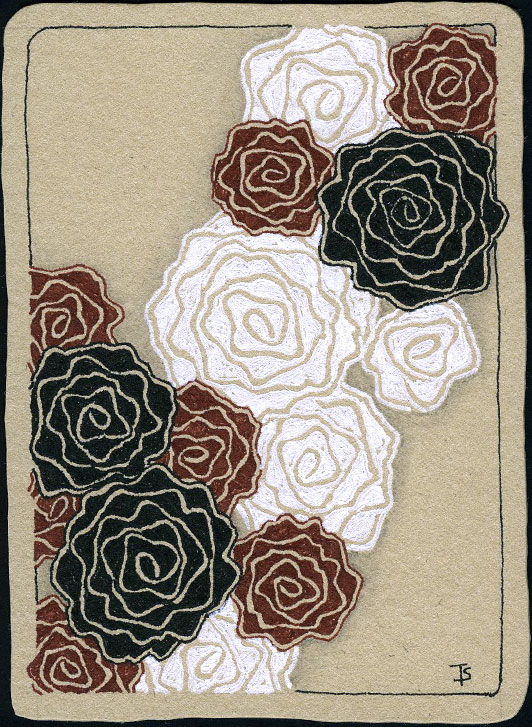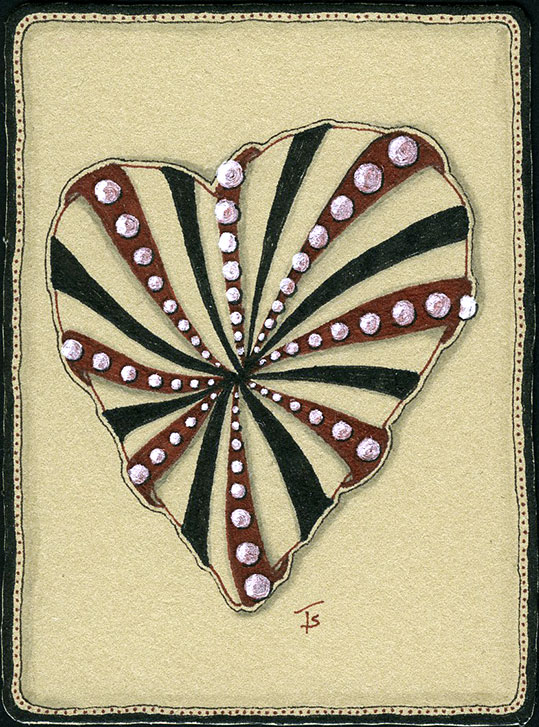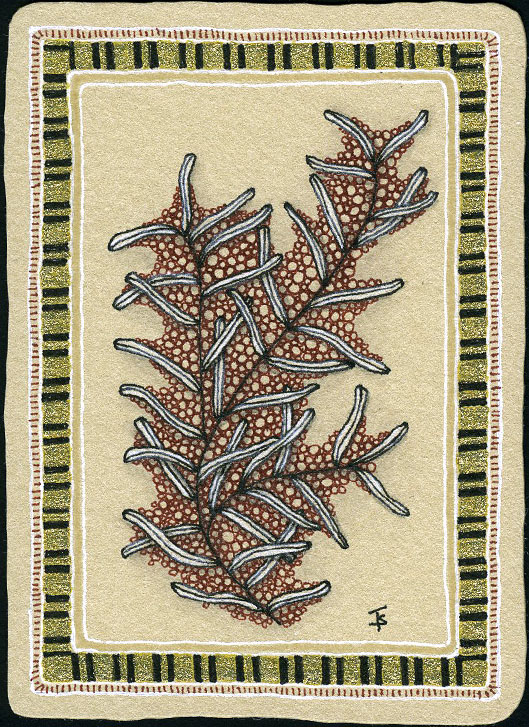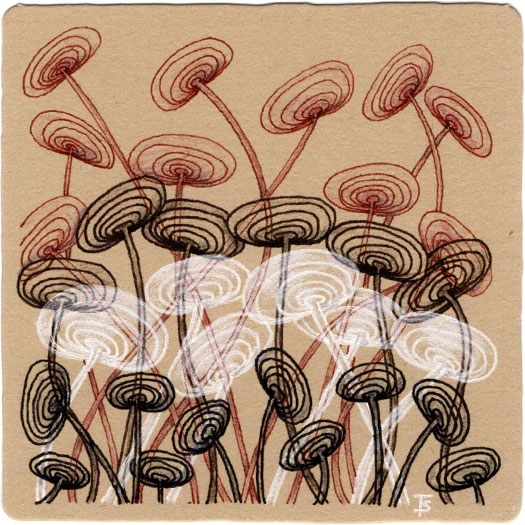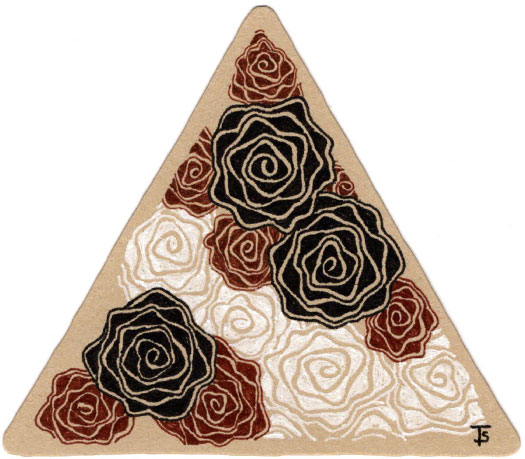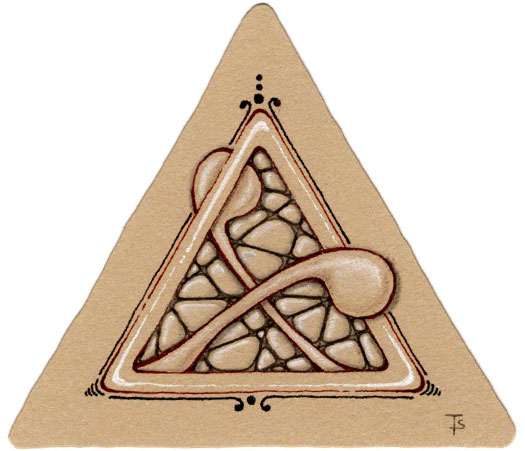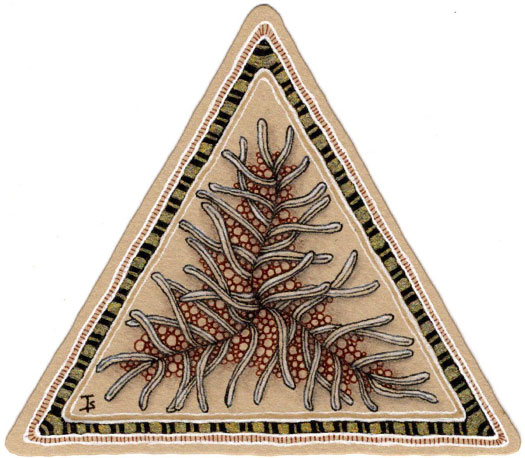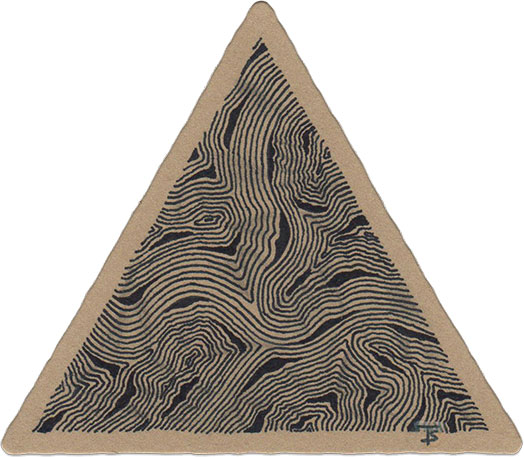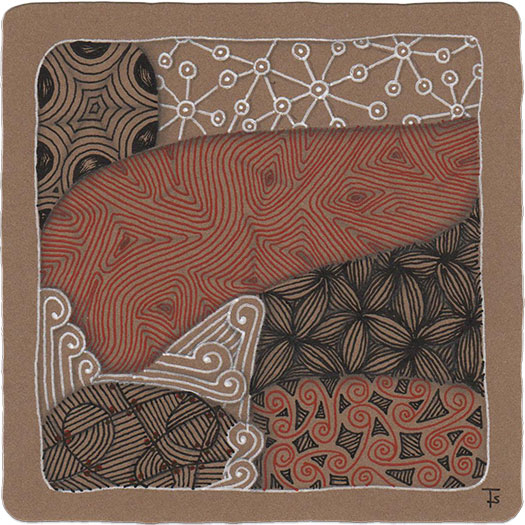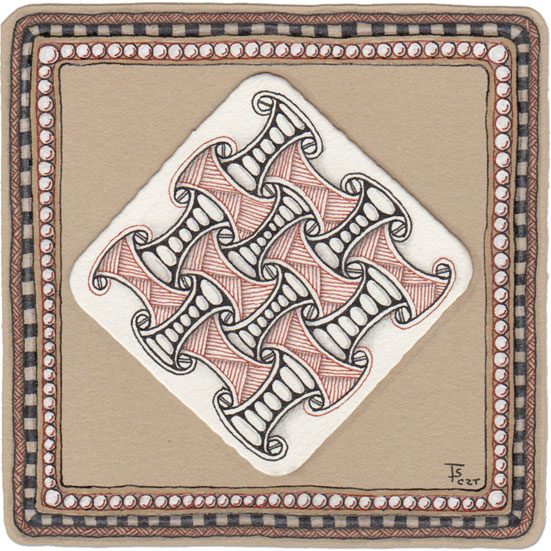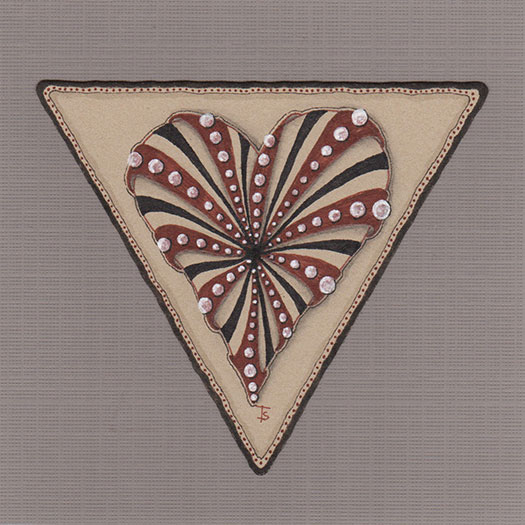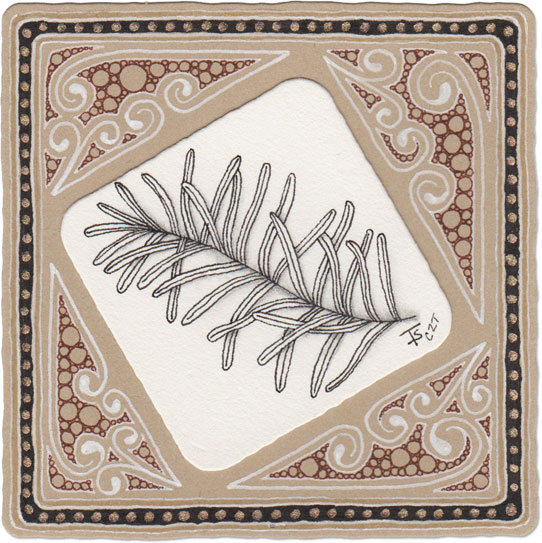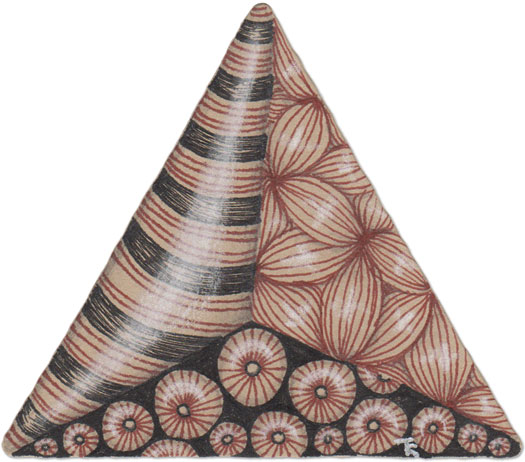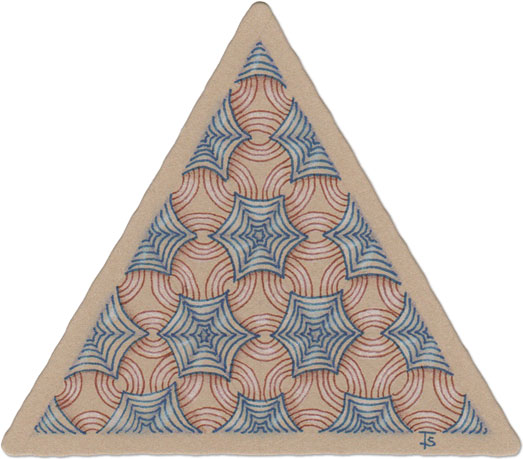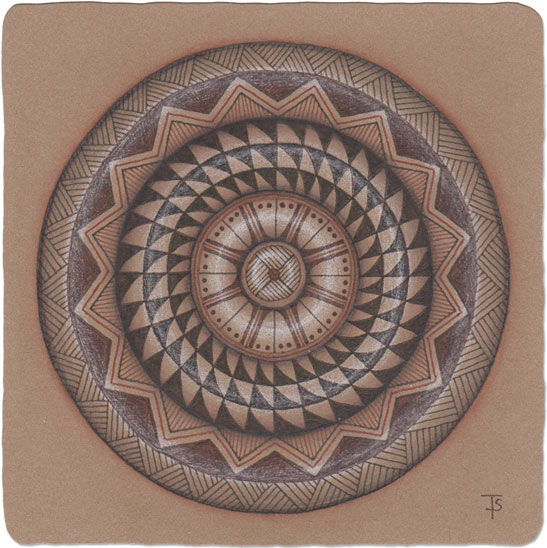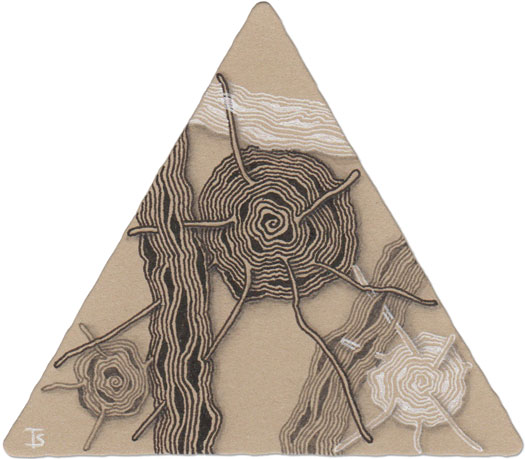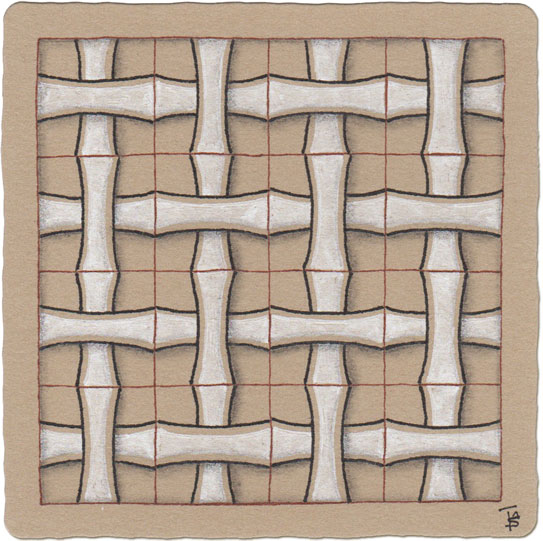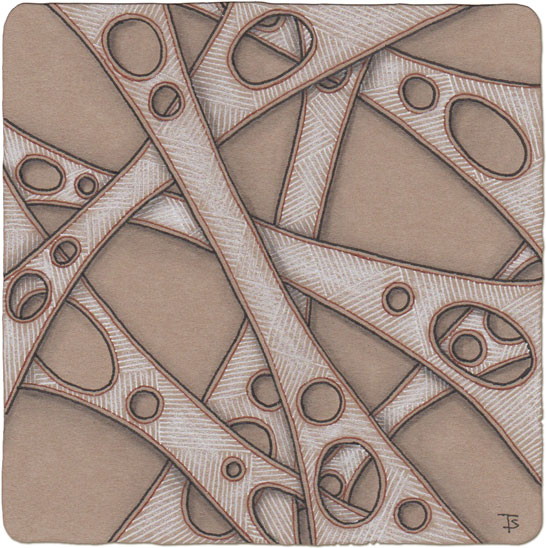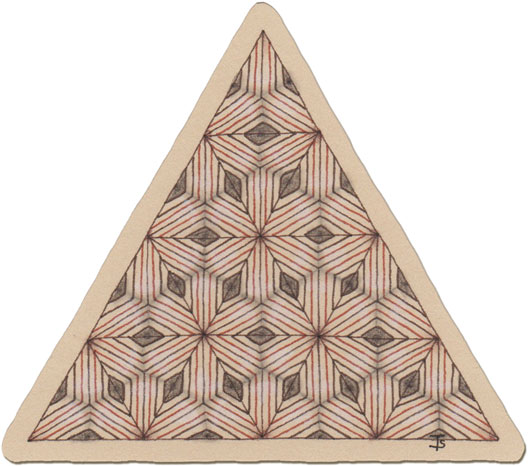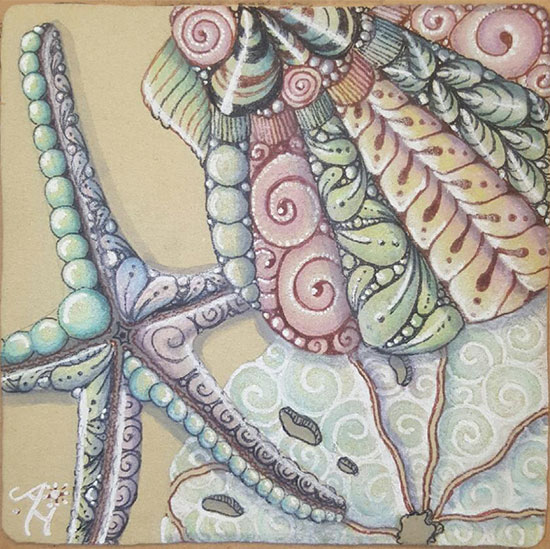Diva Dance is such a fun tangle. Although the concept is very simple, it can morph to fit almost any shape. Or, it can take on a life of it’s own, depending on the variation.
Here, it has been wrapped around itself in a spiraled style that gives the appearance of full-blown blossoms.
ATC #9.
Zentangle drawn on sahara, Fabriano Tiziano using a black and tan, Micron pens and white Gelly Roll. Shading done with graphite pencil.
Aquafleur, the tangle used on the heart-shaped string was one that I didn’t understand well for a long time. I tried it, as it was shown to me, and I just couldn’t figure out how those ribbons wrapped a given string.
Finally, one day, I just sat and played with it in my sketch book. And all of a sudden, it just “clicked” for me.
Here, it is used in an elegant, but simplified version. It’s easier to understand when wrapped around a single, simple shape.
If you follow me, then you know I’ve done this tangle, which can look like a sprig of Rosemary, or a pine bough, or a feather, many times before. I enjoy drawing it and it’s one of my favorites.
ATC #7.
Zentangle drawn on sahara, Fabriano Tiziano using a black and tan, Micron pen and gold gel pen. Shading done with graphite pencil.
Tangles: Marasu Tipple Verdigogh
I am not sure what I think about this. It didn’t come out like the picture I had in my mind when I started. On the other hand, I kind of like it. I may try this again, but slightly differently, or with a different tangle.
Zentangle drawn on an Official Zentangle Renaisannce tile using black, sepia and brown Micron pens and a white Gelly Roll pen. Shading done with graphite and colored pencils.
I call this my “Ode to Frida” monotangle. That’s becauseit reminds me of those large flowers that she often wore in her hair, like a crown.
This version of Diva Dance produces strong, graphic, circular elements. So I chose to draw them in three different colors. I like the contrast between the brown, black and white inks.
I also chose not to add any graphite or other shading. I feel that this is one of the few cases where it could detract from the over-all design.
“In typography, a dingbat is an ornament, character, or spacer used in typesetting, often employed for the creation of box frames.” - Wikipedia
We’ve all seen them decorating title pages, the ends of paragraphs or other areas of printed books.
Zentangle, and CZT Brian Crimmins in particular, has created a tangled version of this classic concept. It is called Dingbatz, in honor of it’s typographical cousin. Here, we use the stylistic shapes and concepts of the original, but employ tangles as graphical elements.
I love tangling on tan! It opens the door to so many different and interesting possiblities. And I never know how it will actually turn out.
This was inspired by another Zentangle that I did last year. But I wanted to change it up some, and recreate it on a triangular tile.
Although it didn’t show up well on the scan, I used gold ink on top of the black band on the border to create a Marasu pattern. And I used a brown pen to draw the Tipple bubbles around the central Verdigogh fronds.
Northwest.
Various parts of the country have a history of native, tribal art which influences the decorative choices of that particular area. Recently, my husband traveled to Portland, Oregon for a business conference. While there, he found a book, "Looking at Indian Art of the Northwest Coast" by Hilary Stewart.
I like the graphic effect produced by using black, white and red. So I decided to give it a try on a Zentangle. I don’t know how effective it is here, but it was an interesting exercise.
All dressed up.
This little bijou is a remake of one I did at the CZT seminar. I decided to dress it up a bit by mounting it on a tan tile and adding a few frames. Huggins has become one of my favorite, meditative tangles!
Zentangle drawn on an Official Zentangle Bijou tile using a black and brown, Pigma Micron pens and white, Sakura Gelly Roll. Shading done with graphite pencil and Copic markers.
This is another tile that I, unfortunately, left at Seminar. But I have to say that I actually like this version better! I normally put finished tiles in my scrapbook on a black background. But here, I decided to change it up a bit because I made the edge of the 3Z black. With it on a taupe background, I think it stands out better.
Zentangle drawn on an Official Zentangle 3Z tile using a black, sepia and brown, Pigma Micron pens and white Sakura Gelly Roll pen. Shading done with graphite pencil and Copic marker.
Remembrance.
As we walk on this path, I am reminded to spend time with others I’m walking here with. The time will go so fast and we will, literally, be scattered to all the corners of the earth. But we will remember each other, and this special time here.
This beautiful, rosemary stem is drawn using the tangle Verdigogh. Rosemary is for rememberance. I wanted to add something to it, but I couldn’t decide what. Then I realized the Renaissance frame would be perfect. So this frame was drawn on July 3, 2018 and I set the tile from the CZT 30 Seminar in the center of it. I wanted to honor, treasure and remember my time there.
One of the things I love about tan tiles is the ability to add both shades of grey and white highlights. In addition, these tiles are perfect for both brown, black and even white ink, creating lots of variety. All of these factors, added together take simple tangles to a much more sophisticated level!
Zentangle drawn on a tan Official Zentangle 3Z tile using black and brown, Pigma Micron pens. Shading done with graphite pencil. Highlights done with white charcoal pencil.
I’m building a library of tiles done with a single fragment from the Zentangle Primer. Today, I decided to tackle J15, using blue and brown ink. I love the effect this tangle produced when used en masse. The large, interlocking circles receded to stand behind the blue, web-like shapes, so I simply accented the illusion by shading with the appropriate colored pencil.
Creating tiles like this, with fragments, is kind of like discovering buried treasure. You try to visualize what they will look like, but even if you understand the pattern, actually seeing it is still surprising!
While I was working on yesterday’s tile, I was thinking that I would like to try this technique on a tan tile, with a Southwestern, Native American pottery theme.
I gave it a shot here. I’m not totally enthralled with it because I feel like the entire tile reads too “brown,” without enough light contrast. I will probably give this another try over the weekend. That said, I do like the tile for what it is!
Armed.
As she looked into the tank, she could see that these creatures had some kind of appendages that sort of sproinged out of their bodies. They ranged in all sizes from teeny tiny to so large she couldn’t even see the body in the murk. It looked as if the smaller ones became entwined in the larger as they grew. But wouldn’t these prisoners become a burden over time?
Bones.
Their culture was built on the bones of their ancestors. The believed these relics spoke to them, leading them towards the future without forgetting their past.
This is another tile celebrating and exploring fragments. This is B2 from the Zentangle Primer. I ended up not putting the second set of lines inside each shape and just let the color define the areas. I chose to stop because it looked so much like a grid of bones. I just wanted to let it be.
WhollyHollibaugh.
Recently, Zentangle released a new video, #18, in the Kitchen Table series that illustrated the principle of seeing behind parts of a design through a window, or cutout in a tangle. Hollibaugh was used to illustrate this, so I decided to create this tile for my collection showing the concept. They call the tangle enhancement “Wholly Hollibaugh.”
Zentangle drawn on Stonehenge Kraft using black and brown Pigma Micron pens and Sakura white gel pen. Shading done with Copic marker and graphite and colored pencil.
Reticula.
I happen to love optical illusions. I think that’s one of the reasons that I love exploring Zentangle reticulum. By using some careful shading, this tile may look like a series of “Ys” or it may look like “blossoms”. Prior to shading, it looks a bit like the tangle Fassett! It’s a lot of fun to play with. The fragment used here is B13 from the Zentangle Primer.
This wonderful tile was created by my daughter. She is my student and protégé! She is such an amazing artist and she loves to be my class tester. It never ceases to amaze me what she will do and whether she will change something because she likes her way better. I’m so proud of her and so happy we will both become CZTs at the same seminar!
She saw my similar tile and asked me to teach her how to do it. It’s always a great opportunity for me to have a “practice student!” And it’s so much fun to work together.
